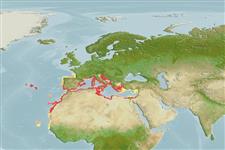Common names from other countries
Classification / Names / Names
आम नाम | उपशब्द | Catalog of Fishes (gen., sp.) | ITIS | CoL | WoRMS
Environment: milieu / climate zone / depth range / distribution range
पारिस्थितिकी
; गहराई सीमा 4 - 100 m (Ref. 4). Subtropical, preferred 20°C (Ref. 107945); 46°N - 13°N, 32°W - 36°E (Ref. 4)
Eastern Atlantic and the Mediterranean: from Lisbon, Portugal to Senegal, and the Mediterranean.
Length at first maturity / आकार / वज़न / Age
Maturity: Lm ? range ? - ? cm Max length : 45.0 cm TL पुल्लिंग / अलिंग; (Ref. 4); common length : 36.0 cm TL पुल्लिंग / अलिंग; (Ref. 441)
Carapace length: 12 cm. Occurs at depths between 4 and 100 m on rocky or sandy substrate. Feeds on mollusks, especially limpets (Patella sp.). Ovigerous females are observed from June to August (Ref. 4).
Life cycle and mating behavior
परिपक्व अवधि | पुनरुत्पत्ति | मछलीऔ का अंडे देना | अंडे | Fecundity | लार्वा
Ovigerous females from June to August (Ref. 4).
Holthuis, L.B. 1991. (Ref. 4)
IUCN Red List Status (Ref. 130435)
CITES status (Ref. 108899)
Not Evaluated
Not Evaluated
Human uses
मात्स्यिकी: व्यापारिक
FAO - मात्स्यिकी: landings | FishSource | Sea Around Us
साधन
इंटरनेट स्रोत
Estimates based on models
Preferred temperature
(Ref.
115969): 14.6 - 21.6, mean 18.7 (based on 246 cells).
लौटाव
माध्यम, न्यूनतम जनसंख्या दुगनी होने का समय 1.4 - 4.4 वर्ष। (K=0.2).
Vulnerability
Low to moderate vulnerability (35 of 100).
